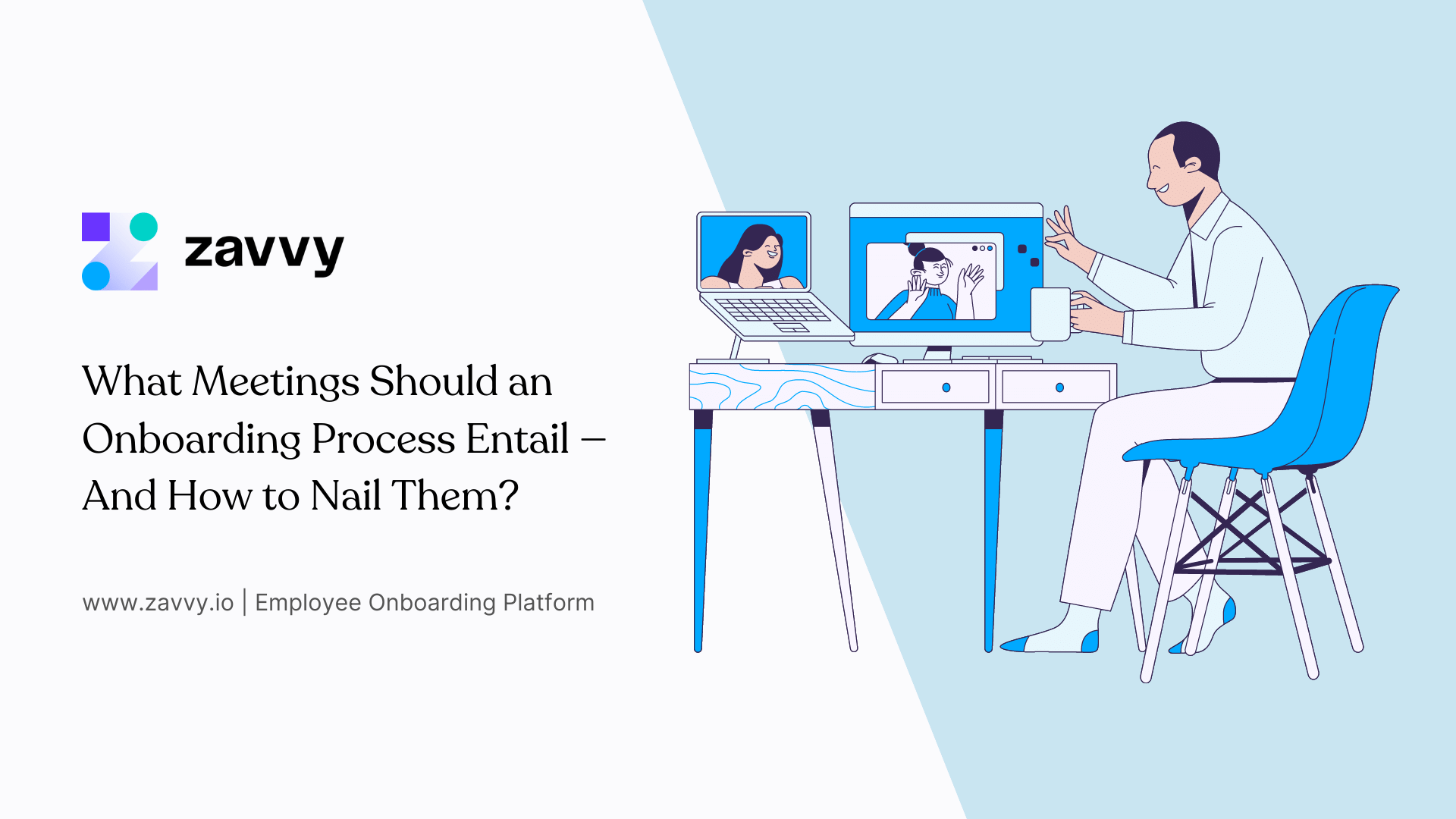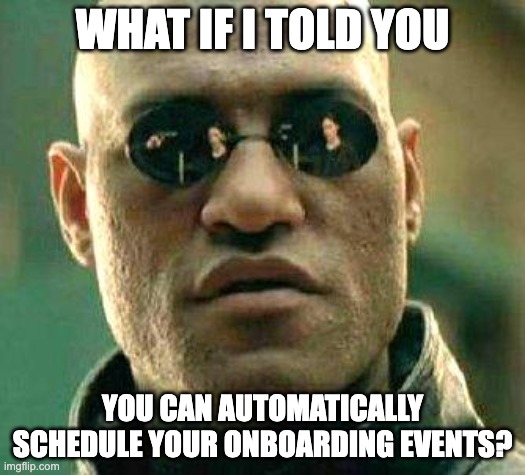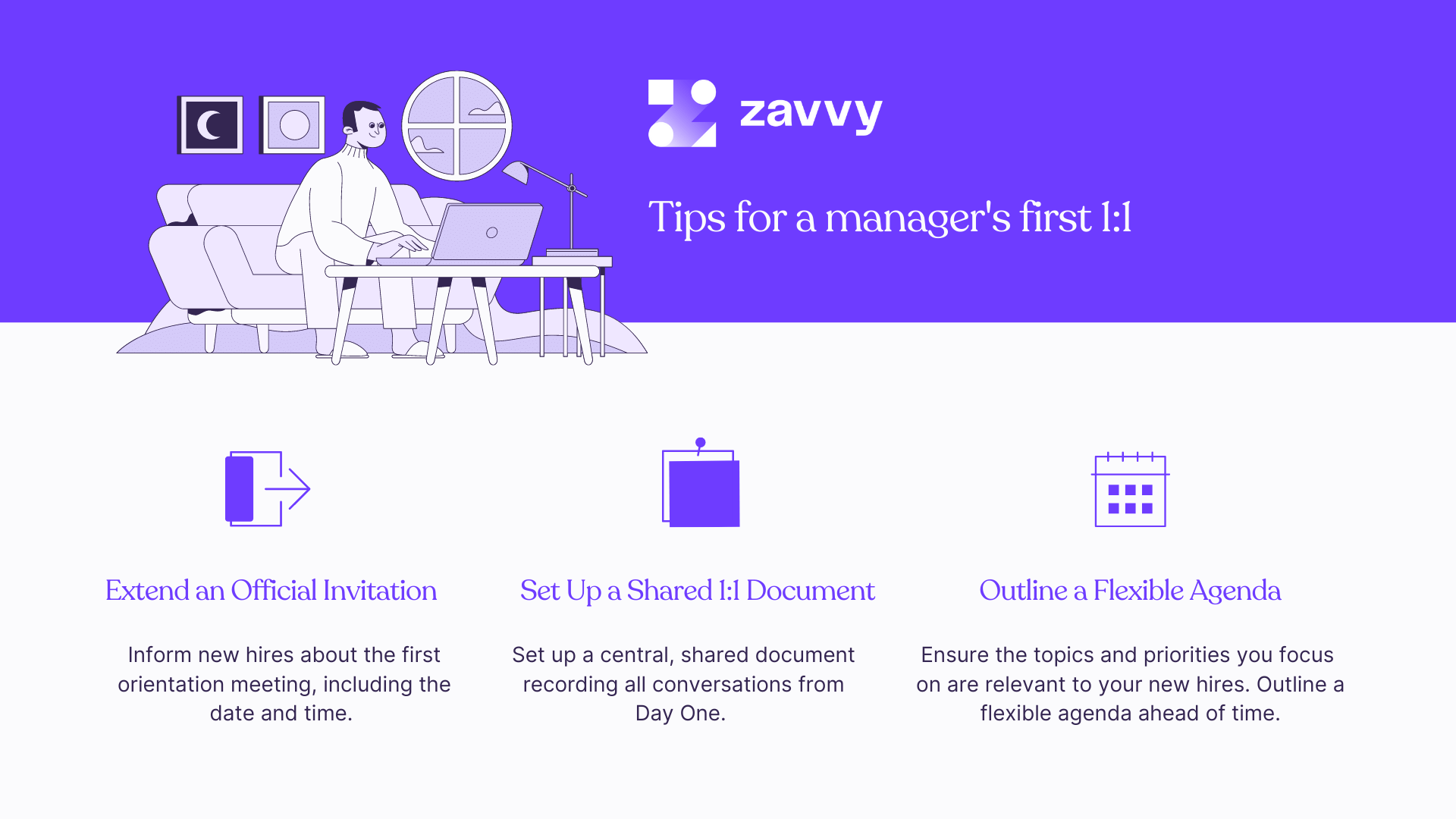
Alexander Heinle
Alex is a marketer at Zavvy. On this blog, he mainly shares insights gained from discussions with selected experts and from helping our customers set up and improve their onboarding or learning programs.


A thoughtfully crafted employee onboarding process is critical to making new hires feel confident in their new roles and improving employee retention and engagement.
But you already know that. What you want to know is how to improve your employee onboarding experience. Or how to build a good onboarding schedule if you don't already have one.
The answer to more social integration is holding meetings.
How? In-person and virtual onboarding meetings help strengthen social integration and get new employees more comfortable at work. Through these meetings, new hires can complete their paperwork, get introduced to co-workers, and understand what's expected of them.
You can achieve a lot if you get this right, which is why we’ve created this guide. Read on to know the onboarding meetings your onboarding process should entail to engage your new hires.
Together with our curators, we have created a library of actionable digital marketing resources. Personalized to your team's needs.
Employee onboarding refers to strategic activities designed to integrate new employees into the company and its culture. It involves giving new hires access to tools and information that'll help them do their jobs confidently and productively.
.png)
HR professionals agree effective onboarding should take at least three months. At Zavvy, we believe your onboarding process should be tailored to your organizational and employee requirements.
This process should include various onboarding meetings to bring out the best in your new hires that will be spread over the four main phases of onboarding: new employee orientation, role training, role transition, and ongoing development.
Keeping this in mind, let's look at the onboarding meetings that should take place to deliver a great onboarding experience.
Ideal time to hold meeting: First day
Orientation meeting focuses on new hires during their first day or week at the office. It lets you manage expectations and provide general support and reassurance to make them feel comfortable in the new environment.
Give them an office tour and a realistic job preview to avoid miscommunication and curb unrealistic expectations. During the orientation meeting, provide employees access to the hardware and software they need to do their job. Explain how they can use the software to remove any anxiety or uncertainty.
If you have a hybrid work environment, set clear expectations for remote and in-person employees right away. Cross-departmental coordination is also important to remove administrative confusion and ensure new hires have what they need, where they need it, and anything else they would need to be productive from Day 1.
Ideal time to hold meeting: Within the first three days
Schedule a meeting for new hires to meet and greet other team members and build connections. While you can opt for a formal setup, we recommend creating a more casual environment where teams can connect. Organizing a team lunch or after-hour party, for one, is a tried-and-tested setting for casual team introductions.
Ensure the rest of your workforce knows when new employees arrive and encourage them to plan some quality time. You can also hold fun games to make a lasting impression. For example, play Photo Hunt, where you'll give new employees pictures of their co-workers along with a list of names they have to match.
Ideal time to hold meeting: At the beginning of the first week, followed by recurring weekly meetings
Onboarding is equally exciting and stressful, but an effective onboarding buddy program can take away most of the new hire's anxiety and ensure a positive and productive experience with your company.
"Buddies" are peers who help new hires for a specific period, making them comfortable within the brand-new company culture. Alternatively, you can assign mentors to your new hires. Mentors are non-peers or senior employees of the company who will be responsible for the new employees' short and long-term career development.
Schedule one-on-one meetings with the new employee's mentor or buddy to familiarize them with the way your company works and provide helpful feedback to do their job better.
Ideal time to hold meeting: At the beginning of the first week, followed by recurring monthly or six-monthly meetings
New employees may or may not have regular access to your CEO or executive team, depending on your company size.
If your company is smaller, organize a one-on-one session between the new hires and the CEO. If this isn't possible because of location or time constraints, you still need a meeting that allows new employees to interact with the CEO or executive team. Think: holding a group meeting to get everyone together.
Get the CEO to chat with the new hires, setting expectations and motivating them to do their best. This will instill a sense of confidence in your new workforce, which will make them more proactive and proactive at work.
Ideal time to hold meeting: At the beginning of the first week, followed by every intra-departmental meeting
Schedule short cross-departmental meetings between the new hires and departmental heads and team members that new employees will be involved with during their tenure.
Use this as an opportunity to share updates and future plans. Encourage the new employees to participate in the meetings and address any issues and concerns they may have. This will help deepen interdepartmental relationships and increase collaboration while making the new hires more comfortable within the new work atmosphere.
Besides departmental heads, you can also schedule meetings with internal subject matter experts (SMEs) to get them up to speed and better understand their purpose at the company.
Ideal time to hold meeting: Second or third week
Often, employees have excellent ideas bubbling away under the surface but lack the forum to express them. Product meetings give them the structure to share and collaborate more effectively.
Inviting new employees to attend product meetings keeps them informed and opens the lines of communication between the members. It also gives them a source of inspiration to think more freely and provide fresh suggestions.
For instance, have each new employee share 1-3 ideas they think will be useful and productive for the meeting. Not only will this move make them feel more comfortable but also supply managers with handy and innovative ideas.
Ideal time to hold meeting: At the beginning of the first week, followed by recurring meetings
Since an onboarding and training program helps familiarize new employees with the company and their responsibilities, holding training meetings is a critical step.
These meetings can refer to onboarding, compliance training, process training, role-specific training, and elective training that will benefit new employees throughout their tenure. For instance, role-specific and process training get them acclimated to their individual jobs, while elective training enables employees to develop competencies and skills they're most interested in.
Ideal time to hold meeting: Bi-weekly
Connection meetings allow employees to create meaningful connections, regardless of their geographical location and rank within the organization.
For instance, Zavvy offers connection programs that automatically connect colleagues through Slack or other tools for casual meetups, walking meetings, and meaningful conversations to improve team spirit, mental health, and productivity. These kinds of onboarding meetings are particularly useful for remote workers, making them feel less stressed, burned out, and lonely.
Ideal time to hold meeting: Every three months or six months
Conducting new employee performance review sets your new workforce up for success in their respective positions, which also reduces turnover.
These meetings are early evaluations to let employees know you have a vested interest in helping them realize their professional goals and enhance their skills. It also enables you to catch and correct performance deficiencies, ensuring they don't become a detriment to their growth and job.
Another advantage of holding feedback meetings is to check in with employees regarding their progress and well-being. It also gives them a platform to voice their suggestions and provide feedback.

You need to hold various one-time and recurring meetings to provide a smooth onboarding experience to your employees. The problem is scheduling these meetings involves a significant amount of time.
A full-time onboarding manager told the Zavvy team she spends 50% of her time scheduling meetings—and that's not including attending and managing those meetings. Just imagine how much time she'll have left to focus on the more important parts of her job if she automated meeting scheduling.

Use Zavvy's onboarding event automation feature to set up recurring events—new hire orientation, meetups, lunch, and office tours—that get automatically scheduled in the new employees' calendars. Just name a preferred day and time, after which our platform will check your new employees' availability before automatically scheduling a meeting for you.
➡️ Get a demo and we'll show you how it works!
Use the following new hire orientation agenda as a template for a first-day orientation meeting.
At the registration table, give employees all the necessary paperwork and swag, followed by a catered breakfast where new hires can meet with each other and existing employees to create a welcoming first impression.
Gather your new hires for an onboarding presentation, giving them an overview of what they can expect from the orientation and how to use the information to successfully execute their responsibilities.
At this stage, cover your organizational history, company mission and core values, and deep dive into your company culture. Get new hires excited to be working with your team.
Break your new hires into division-specific groups to better acquaint them with their team members. This also creates a less intimidating environment to meet their immediate managers.
Give the new hires a mental break and provide them a catered lunch, getting them ready for the next phase of the orientation.
Have executive team members speak with new employees and welcome them to the company. Alternatively, you can play a welcome video from the executive team to play during this time.
Cover the most important information concerning your company, such as your key policies and procedures. Hand over handbooks to new employees and have them sign an acknowledgment of receipt after orientation.
Give employees the chance to stretch their legs by for biting them a tour of the office. You can also use this time to provide more information about the company culture and work environment.
Complete the new hire orientation by covering key procedures and having employees complete the required paperwork. Go over common FAQs and make a point to answer any unanswered questions. Also, let them know what the next few weeks will bring in terms of onboarding.

Long gone are the days where orientation for new hires included manually tracking tasks in Excel and showing obsolete onboarding slides—tasks that often led to inconsistent onboarding quality.
Luckily, things have changed for the better.
Here's a short outline of how you can hold your first meeting with your employee to build a healthy manager-employee relationship:
Inform your new employees about the first orientation meeting, including the date and time.
Send an email invite explaining the purpose and sharing the meeting agenda outlining what you'll be discussing in the meeting. This way, employees will know what to expect and can come prepared.
Set up a central, shared document recording all conversations from Day 1. Take notes, share agendas, assign assignments, record feedback, and document decisions.
This provides new hires anytime-anywhere access to important information, keeping everyone on the same page to ensure accountability and prevent miscommunication. Plus, having an archive of past conversations serves as a reference point, making it easier for you to follow up on issues.
Alternatively, you can use an employee onboarding software like Zavvy to automate this process.
Your new hire orientation agenda should cover the following key points:
Make sure the topics and priorities you focus on are relevant to your new workforce. Outline a flexible agenda ahead of time so that you don't miss anything.
Upskill your team every week with the best contents and personalized recommendations.

A thoughtfully crafted employee onboarding process is critical to making new hires feel confident in their new roles and improving employee retention and engagement.
But you already know that. What you want to know is how to improve your employee onboarding experience. Or how to build a good onboarding schedule if you don't already have one.
The answer to more social integration is holding meetings.
How? In-person and virtual onboarding meetings help strengthen social integration and get new employees more comfortable at work. Through these meetings, new hires can complete their paperwork, get introduced to co-workers, and understand what's expected of them.
You can achieve a lot if you get this right, which is why we’ve created this guide. Read on to know the onboarding meetings your onboarding process should entail to engage your new hires.
Get a demo!
We'll be happy to show you around and answer all your questions.
Trusted by innovative companies



We'll be happy to show you around, answer your questions, or arrange a free trial.
Erhalten Sie eine kostenlose Demo unserer Onboarding-Software.
Vertraut von



Your Training & Development Strategy - Solved in 1 Tool.
Trusted by innovative companies



We'll be happy to show you around, answer your questions, or arrange a free trial.
Learn how Zavvy helps you drive performance, development, and engagement.
Trusted by innovative companies



We'll be happy to show you around, answer your questions, or arrange a free trial.
We'll be happy to show you around and answer all your questions.
Trusted by innovative companies



We'll be happy to show you around, answer your questions, or arrange a free trial.
Gerne zeigen wir Ihnen ganz unverbindlich unsere Plattform im Detail.
Vertraut von modernen Unternehmen



Get a demo!
We'll be happy to show you around and answer all your questions.
Trusted by innovative companies



We'll be happy to show you around, answer your questions, or arrange a free trial.
Erhalten Sie eine kostenlose Demo unserer Software für Mitarbeiterenwicklung und Training.
Moderne Unternehmen
setzen auf Zavvy


